Trial Balance and Rectification of Errors Chapter Notes | Accountancy Class 11 - Commerce PDF Download
Meaning of Trial Balance
A trial balance is a list that shows the total debits and credits from all accounts in the ledger. Its main purpose is to check if the math is correct in the ledger accounts. The trial balance is very important because it shows the overall status of all accounts, helping in preparing the final financial statements. It makes preparing these statements easier by giving a simple summary of all account balances, so you don’t have to check every entry in the ledger. Usually, a trial balance is made at the end of the accounting year, but a business can prepare it anytime—monthly, quarterly, half-yearly, or yearly—depending on what it needs.
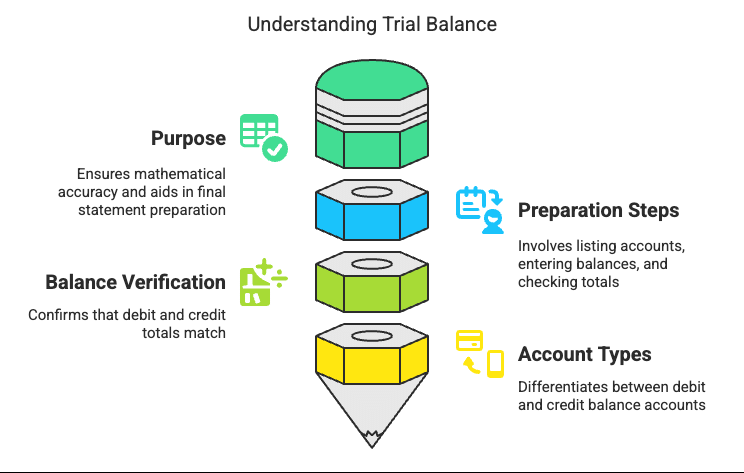
To prepare a trial balance, follow these steps:
- Determine the balances of each account in the ledger.
- List each account and enter its balance in the appropriate debit or credit column.
- Sum the debit and credit columns.
- Check that they match.
However, having a balanced trial balance does not definitively prove that the accounts are accurate. Generally, assets, expenses, and receivables should show debit balances, while liabilities, revenues, and payables should show credit balances.
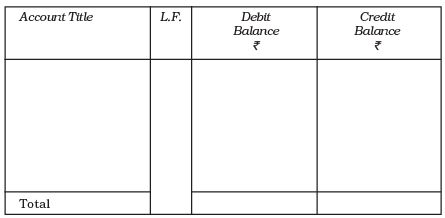 Format of a Trial Balance
Format of a Trial Balance
Remember that:
- All assets, expenses, and receivables accounts should have debit balances.
- All liabilities, revenues, and payables accounts should have credit balances.
Objectives of Preparing the Trial Balance
The trial balance is created to achieve the following goals:
- To ascertain the arithmetical accuracy of the ledger accounts.
- To assist in locating errors.
- To aid in the preparation of the financial statements, which include the Profit & Loss account and the Balance Sheet.
It should be noted that all assets, expenses, and receivables accounts will have debit balances, while all liabilities, revenues, and payables accounts will have credit balances.
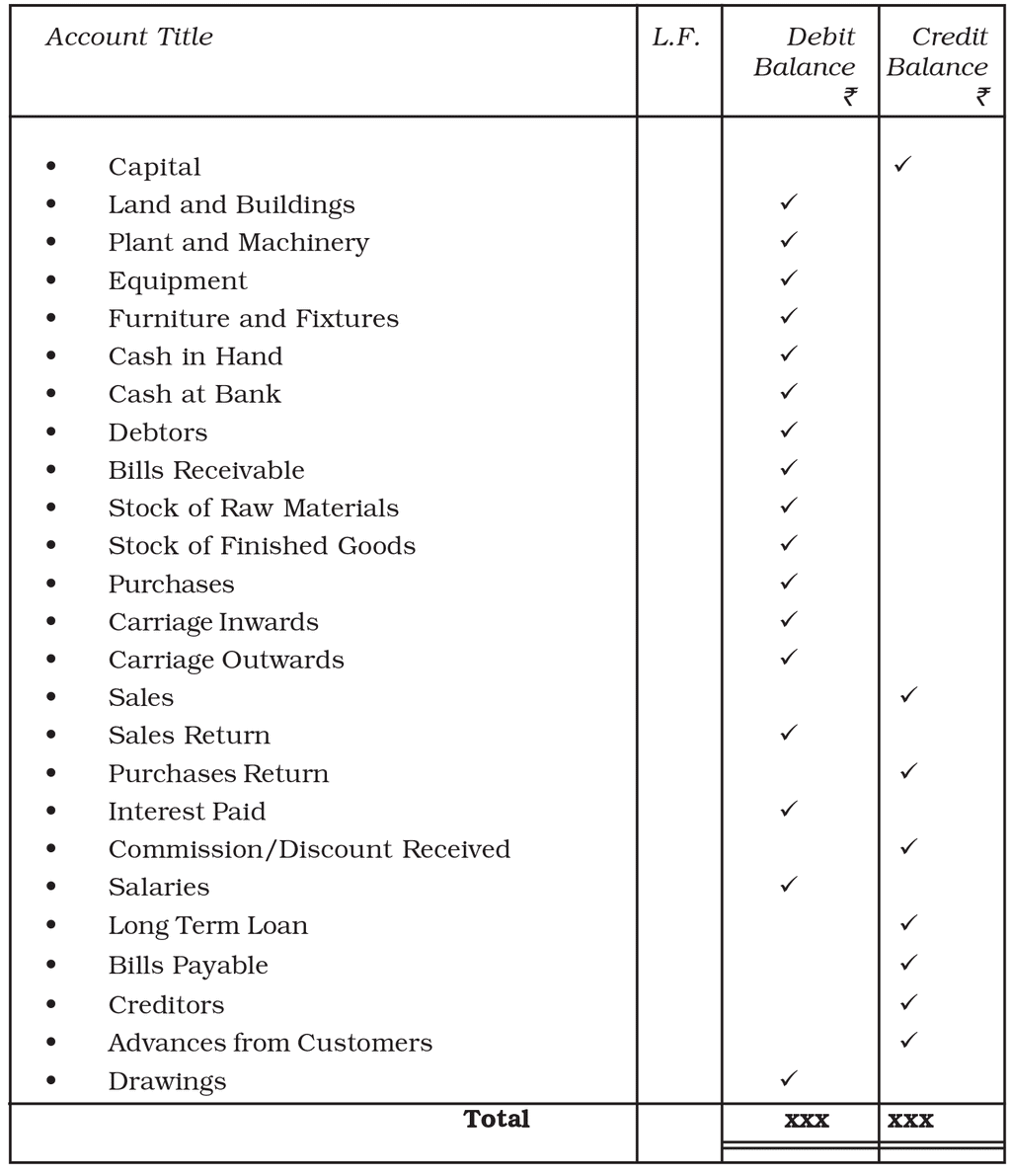
Purpose of the Trial Balance
- The main goal of preparing a trial balance is to check if all the debits and credits have been recorded correctly in the ledger. This helps to make sure that the accounting records are mathematically correct.
- A trial balance acts like a summary of the ledger. It lists all the accounts and shows their balances—how much money is owed or owned in each account.
- If the total of all the debit balances is the same as the total of all the credit balances, it means the accounts are likely correct in terms of addition and subtraction. This is a good sign that the bookkeeping is done properly.
- However, just because the debit and credit totals match, it doesn’t mean everything is 100% accurate. There can still be mistakes like missing entries, wrong amounts, or transactions recorded in the wrong accounts. The matching totals only show that the total debits and credits are balanced, not that every entry is correct.
- So, the trial balance helps catch math errors, but it does not guarantee that there are no mistakes in how transactions were recorded. It is an important step to ensure the accounts are ready for preparing the final financial statements.
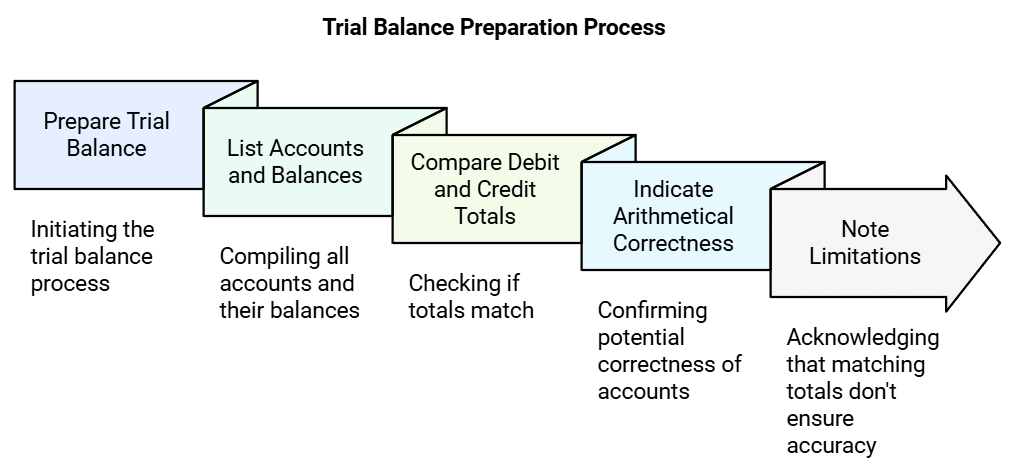
Locating Errors
- If the trial balance does not match (i.e., the totals of the debit and credit columns are different), it means there is at least one error.
- Errors may happen at various stages in the accounting process, including:
1. Calculating totals in subsidiary books.
2. Posting journal entries into the ledger.
3. Calculating account balances.
4. Carrying account balances to the trial balance.
5. Calculating totals for the trial balance columns. - Even if debit and credit totals are equal, it does not ensure all entries are correct because some errors do not affect the equality of debit and credit totals.
- For example:
1. A bookkeeper might debit the right amount to the wrong account, resulting in incorrect balances for two accounts, yet still allowing the trial balance to tally.
2. Another mistake could involve recording an equal debit and credit for an incorrect amount, which also keeps the totals equal but makes the account balances wrong. - Thus, just because the trial balance matches does not mean that all entries in the original books (like journals or cash books) are correct. However, equal totals suggest that certain types of errors likely did not occur.
Preparation of Financial Statements
- The trial balance serves as an important connection between the detailed accounting records and the preparation of financial statements. Instead of going back and checking every single entry in the ledger, accountants use the trial balance because it gives a clear and organised summary of all the account balances.
- Having a trial balance where the total debits equal the total credits is the first important step before making the financial statements. It shows that the basic math is correct and that the accounts are ready for the next stage.
- The trial balance helps make sure that all the amounts recorded as debits and credits are accurate and balanced. This reduces the chance of errors going into the final reports.
- In the process of preparing financial statements, the revenue (income) and expense accounts listed in the trial balance are transferred to the trading and profit and loss account. This account shows the firm’s earnings and costs.
- At the same time, the accounts for liabilities (what the firm owes), capital (owners’ investment), and assets (what the firm owns) are moved to the balance sheet. The balance sheet gives a snapshot of the firm’s financial position at a certain time.
- So, the trial balance acts as a helpful tool to organise all the important figures before preparing the detailed financial reports.
Preparation of Trial Balance
Trial Balance Preparation Methods:- Totals Method
- Balances Method
- Totals-cum-balances Method
Totals Method
- This method involves adding up all the amounts on the debit side and the credit side of the ledger separately. These total amounts are then listed in the trial balance under their correct columns—debit totals in the debit column and credit totals in the credit column.
- The total amount in the debit column must be exactly the same as the total in the credit column. This balance happens because the accounts follow the double-entry system, where every debit has a matching credit.
- However, this method is not used very often in real life. That’s because it does not check if the individual account balances are correct. Also, it doesn’t help much in preparing financial statements, which is a key purpose of the trial balance.
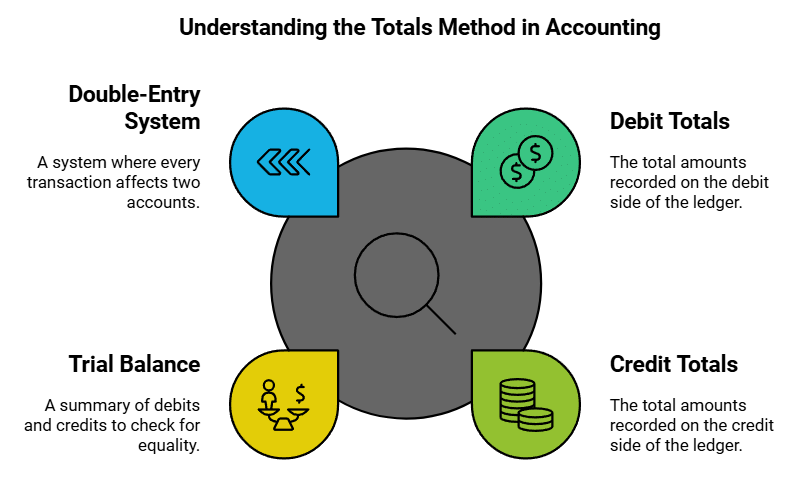
Balances Method
- This is the most frequently used method. It involves preparing the trial balance by listing the balances of all ledger accounts.
- Then, the debit and credit columns are totalled to check their accuracy.
- Account balances are important because they summarise the net effect of all transactions for each account, which is vital for preparing financial statements.
- When preparing financial statements, there is no need to refer back to the ledger.
- In fact, a verified trial balance is the first step in creating financial statements.
- It is worth noting that in the trial balance, instead of showing balances for individual debtor accounts, a figure for sundry debtors is presented, and for individual creditor accounts, a figure for sundry creditors is shown.
Totals-cum-balances Method
- This method combines elements of both the totals method and the balances method.
- It involves creating four columns: two for recording the total amounts of various accounts (debit and credit) and two for displaying the balances of these accounts (debit and credit).
- Despite its comprehensive nature, this method is rarely used in practice because it takes a lot of time and does not provide any significant advantages.

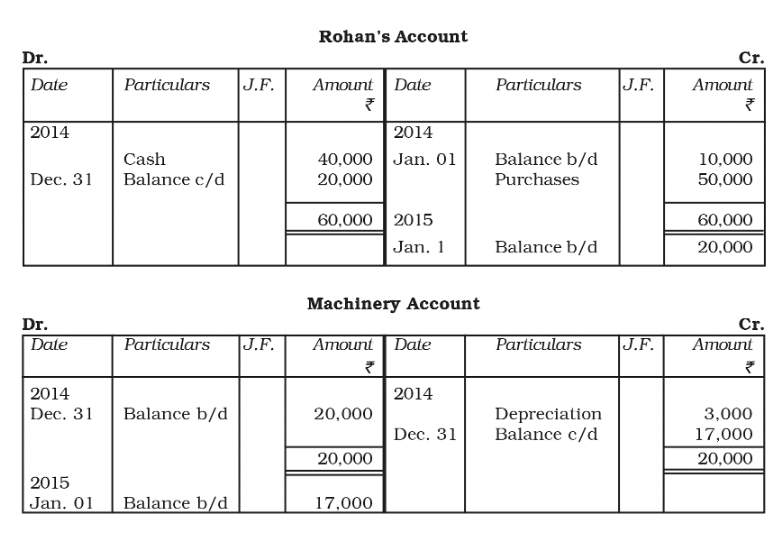

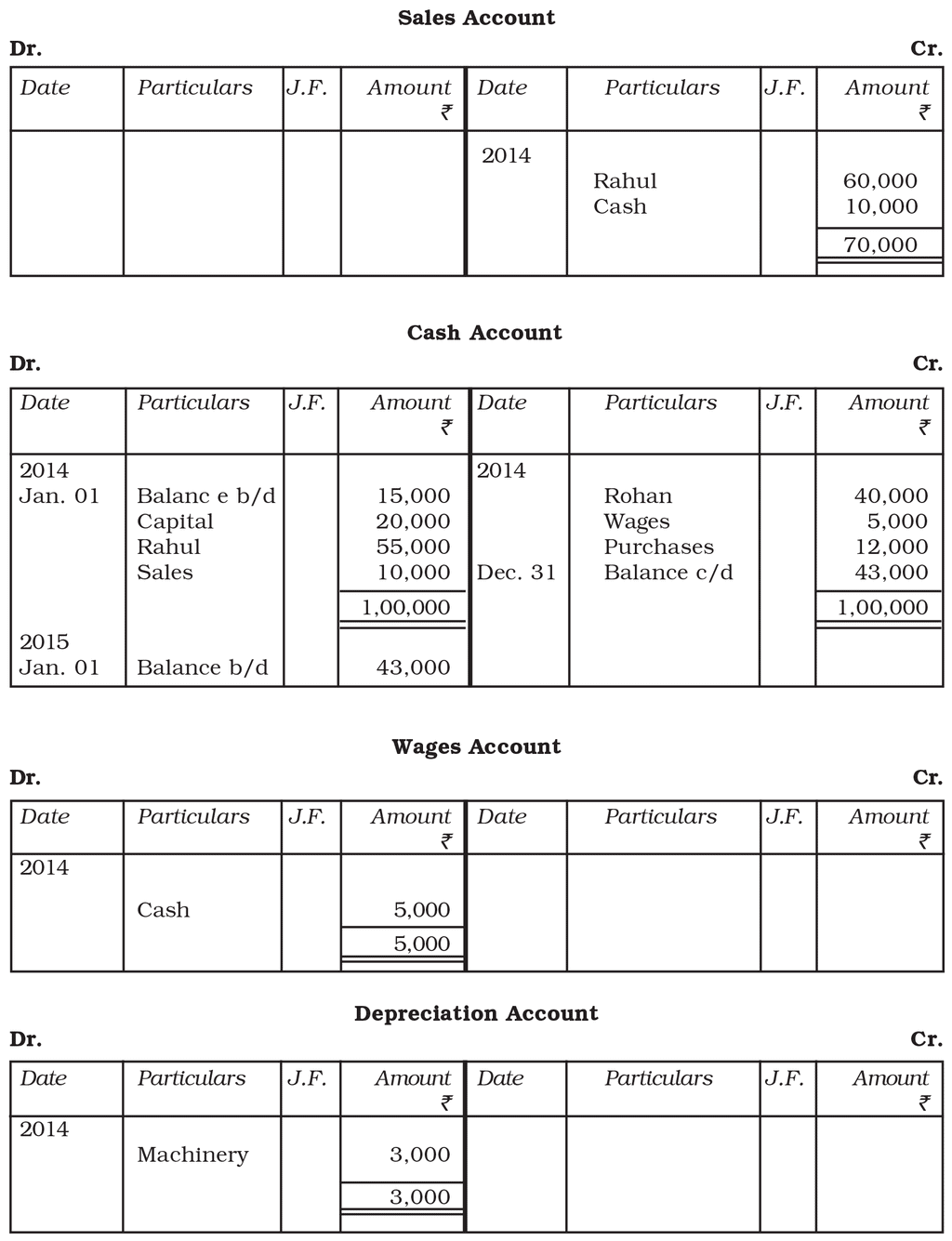
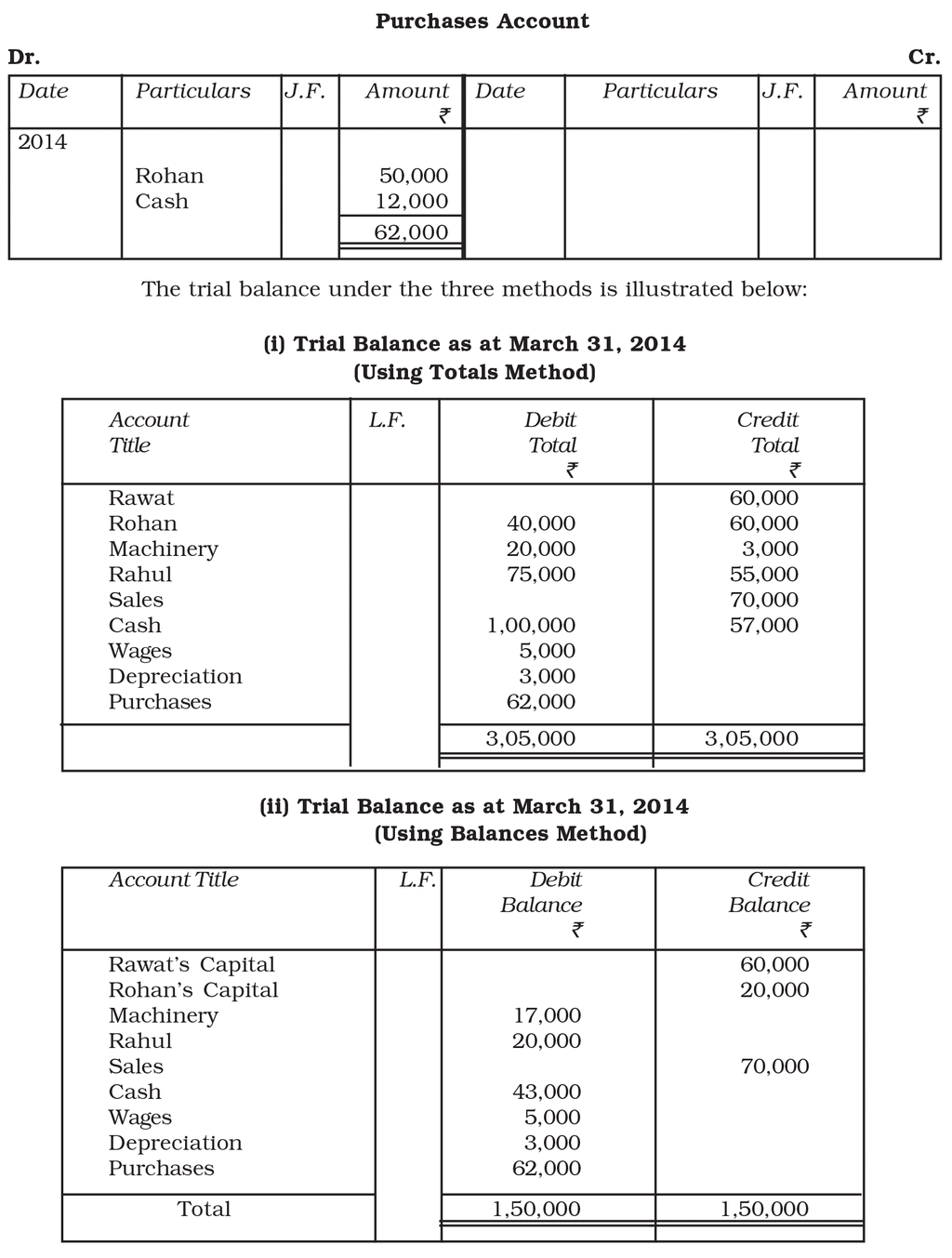
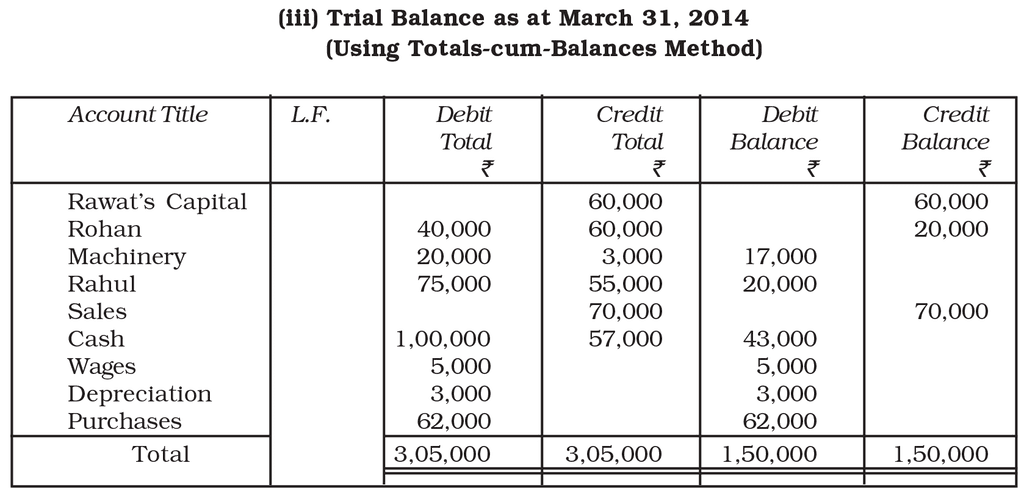
Significance of Agreement of Trial Balance
For an accountant, it is crucial that the trial balance matches. A balanced trial balance indicates that the debit and credit entries for each transaction have been recorded correctly. However, it's important to note that a balanced trial balance does not guarantee the complete accuracy of accounting records. It only suggests that the postings to the ledger are mathematically correct. Still, mistakes may exist that do not affect the balance, or errors might cause the debits and credits to be unequal. Common errors include:- Error in totalling the debit and credit balances in the trial balance.
- Error in totalling subsidiary books.
- Error in posting totals from subsidiary books.
- Error showing account balances in the wrong column or wrong amount in the trial balance.
- Omission of an account balance in the trial balance.
- Error in calculating a ledger account balance.
- Error while posting a journal entry, such as posting the wrong amount, on the wrong side, or in the wrong account.
- Error in recording a transaction in the journal, like making a reverse entry or recording with the wrong amount.
- Error in recording a transaction in the subsidiary book with the wrong name or amount.
Nevertheless, it should be emphasised that the agreement of the trial balance is not definitive proof of the accuracy of accounting records. The trial balance serves as a tool for checking the correctness of debit and credit amounts. It acts as an arithmetical check within the double entry system, ensuring that both sides of each transaction have been accurately recorded.
Classifications of Errors
Considering the nature of errors, they can be categorized into four main types:
- Errors of Commission
- Errors of Omission
- Errors of Principle
- Compensating Errors
1. Errors of Commission:
- These errors occur due to incorrect posting of transactions, wrong totalling, or incorrect balancing of accounts. For example, if Raj Hans Traders paid ₹25,000 to Preetpal Traders but posted only ₹2,500 to Preetpal’s account, this is an error of commission. Such errors are typically clerical in nature and often impact the trial balance.
2. Errors of Omission:
Errors of omission happen either when a transaction is not recorded in the original books or not posted to the ledger. They can be classified into two types:
- Complete Omission: When a transaction is fully omitted, like failing to record credit sales of ₹10,000 to Mohan in the sales book.
- Partial Omission: When part of the transaction is omitted, such as recording sales in the sales book but not posting them to Mohan’s account.
3. Errors of Principle:
- These errors arise from not following proper accounting principles. They may occur due to misclassifying expenses or income between capital and revenue.
- Such mistakes can distort financial statements by inaccurately presenting income or assets, which is critical as it affects financial reporting, but does not influence the trial balance.
4. Compensating Errors:
- Compensating errors arise when multiple mistakes offset each other, leading to no overall effect on the debits and credits. If two or more errors balance out so that the net impact on debits and credits is zero, they are termed compensating errors. These do not affect the trial balance.
- For example, if the purchase book is overstated by ₹10,000 while the sales returns book is understated by the same amount, the trial balance remains unchanged as the errors cancel each other out.
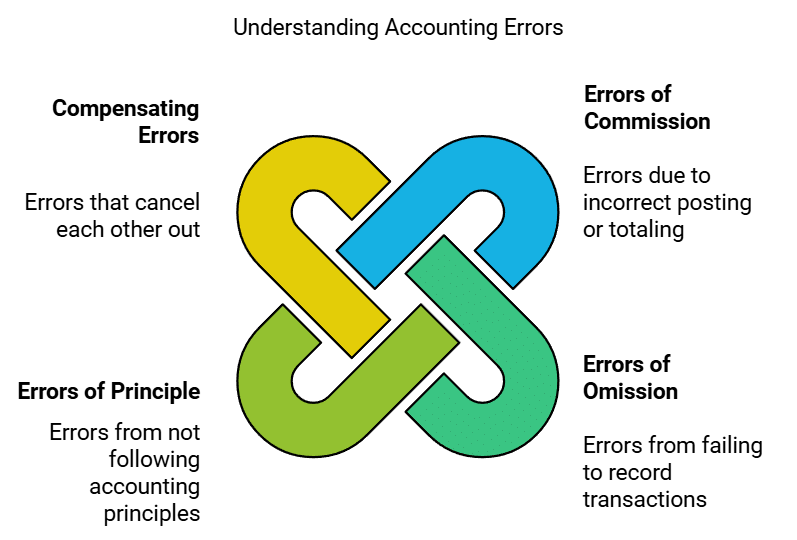
Searching of Errors
If the trial balance does not match, it means there is definitely at least one error in the accounts. These errors need to be found and corrected before preparing the financial statements.
- Even when the debit and credit totals are equal, it doesn’t always mean the accounting is completely accurate. Some mistakes don’t affect the balance of totals.
- However, if the totals are equal, it usually means certain kinds of errors are not present.
To identify and locate the errors, the accountant should follow these steps:
- Recalculate the totals of the debit and credit columns in the trial balance.
- Check the account names and amounts in the trial balance against those in the ledger to find any discrepancies or missing accounts.
- Compare the current year's trial balance with the previous year's to spot any added or removed accounts and to see if there are any unexpected large differences.
- Reassess the accuracy of the balances for each individual account in the ledger.
- Double-check that postings from the original records into the accounts are correct.
- If the difference between the debit and credit columns can be divided by 2, it might mean that an amount equal to half of the difference was incorrectly posted in another account. For example, if the debit total is greater by 1,500, it might be that a credit of 750 was mistakenly recorded as a debit. The accountant should review all debit entries of 750.
- The difference may also suggest that a posting was completely missed. For instance, a difference of 1,500 could be because a credit of that amount was not posted. Thus, the accountant should check all credit entries of 1,500.
- If the difference is a multiple of 9, it could indicate a transposition error. For example, if 459 is recorded as 954, the debit total would exceed the credit side by 495 (i.e., 954 - 459 = 495). This difference is divisible by 9. Errors due to a misplaced decimal point can also be checked using this method.
Rectification of Errors
Errors can be divided into two main types based on their impact on the trial balance:- Errors that do not affect the trial balance
- Errors that affect the trial balance
This distinction is important because:
- Errors that do not affect the trial balance usually involve two accounts, making them easy to fix with a journal entry.
- Errors that do affect the trial balance typically involve one account, and fixing them may require a suspense account unless a journal entry is made.
Rectification of Errors that Do Not Affect the Trial Balance
These types of errors happen in two or more accounts and are often called two-sided errors. They can be corrected by making a journal entry that adjusts the correct debit and credit for the involved accounts. Examples of these errors include:
- Not recording an entry in the original books.
- Incorrectly recording transactions in the accounts.
- Failing to post to the correct account on the right side.
- Errors based on principles.
The process of rectification involves the following steps:
- Cancelling the impact of the wrong debit or credit by reversing it.
- Restoring the impact of the correct debit or credit.
To analyse the error, consider its effect on the accounts, which may include:
- A short debit or credit in an account.
- Excess debit or credit in an account.
Thus, a rectification entry can be made by:
- Debiting the account with a short debit or with an excess credit.
- Crediting the account with the excess debit or with the short credit.
Let's understand this better with the help of a few examples:
1. A credit sale of ₹ 10,000 to Mohan was not entered in the sales book. This is an example of an error known as complete omission.
- Because of this mistake:
- Mohan's account has not been charged.
- The Sales account has not received the appropriate credit.
- To fix this mistake, the usual entry for the credit sale needs to be recorded.

2. Credit sales to Mohan 10,000 were recorded as 1,000 in the sales book. This is an error of commission. The effect of wrong recording is shown below:

The correct recording should have been:

- Now, Mohan's account needs an extra debit of ₹ 9,000.
- Additionally, the sales account requires a credit of ₹ 9,000.
- To correct this, the entry for rectification will be:

3. Credit sales made to Mohan for ₹ 10,000 were mistakenly entered as ₹ 12,000.
- This mistake is known as a commission error.
- The incorrect amount recorded has the following effects:
- It causes a difference in the financial records.
- The total sales amount will appear higher than it actually is.
- This could lead to misleading financial statements.
- There may be issues with accounting accuracy in reports.
- It might affect the commission calculations for sales staff.
The incorrect entry looks like this:

The correct entry should have been:

- There is a surplus debit of 2,000 in Mohan's account.
- There is also an extra credit of 2,000 in the sales account.
- To fix this issue, a rectification entry will be made as follows:

4. A sale of ₹ 10,000 to Mohan was accurately entered in the sales book.
- However, the amount was mistakenly recorded in Ram's account instead.
- This mistake is known as an error of commission.
- The result of this incorrect posting has several effects:
- Mohan's account does not reflect the sale that occurred.
- Ram's account incorrectly shows a sale that he did not make.
- This error can lead to confusion in financial records.
- It may affect the overall accuracy of the company's accounting.
- The effect of the wrong posting has been:

The correct effect should have been:

- Notice that there is no error in the sales account.
- But Ram’s account has been debited with 10,000 instead of Mohan’s account.

5. The rent amount of 2,000 was incorrectly recorded as a payment made to the landlord in the cashbook. The effect of wrong posting has been:

The correct effect should have been:

- The landlord's account has been incorrectly charged instead of the rent account.
- Therefore, a correction entry will be made to fix this mistake.
- This entry is necessary to ensure that the financial records are accurate.

Rectification of Errors Affecting Trial Balance
The errors affecting a single account can be fixed by providing a clear note in the account that is impacted or by making a journal entry using a Suspense Account.- Examples of such errors include:
1. Error in casting
2. Error of carrying forward
3. Error in balancing
4. Error of posting to the correct account but with the wrong amount
5. Error of posting to the correct account but on the wrong side
6. Posting to the wrong side with the wrong amount
7. Omitting to show an account in the trial balance - If you find a mistake in the original entry books before they are recorded in the ledger, you can fix it by drawing a single line through the wrong amount.
- If the wrong amount is recorded in the correct ledger account, you can correct it in the same way or by making an additional entry for the difference.
- Make sure to add a note in the particulars column to explain the correction.
- It is important to avoid fixing mistakes by erasing or overwriting them, as this can damage the trustworthiness of the accounting records.
- Erasing can give the impression that you are hiding something.
- A better way to correct errors is to note the correction on the right side to balance out the error's impact.
For example, if Shyam’s account was under-credited by ₹ 190, this can be corrected by making an additional entry of ₹ 190 on the credit side of his account.

Consider another example:
- The purchases book showed a shortage of 1,000.
- This entry impacts the purchases account, specifically on the debit side.
- The total amount recorded in the purchases book is updated accordingly.
- It’s important to accurately reflect this adjustment in the financial records.

Suspense Account
- When the trial balance doesn't match because of one-sided errors, the accountant must continue working on the financial statements.
- To balance the trial, the accountant records the difference on the shorter side as a suspense account.
The process of opening of suspense account can be understood with the help of the following example:
Consider the sales book of an organisation.
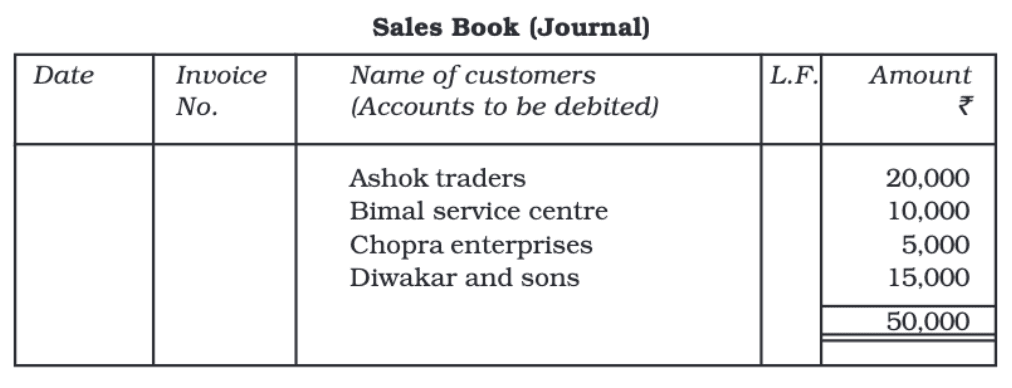
If the sales made to Diwakar and Sons were not recorded in their account, the ledger would reflect the following situation:
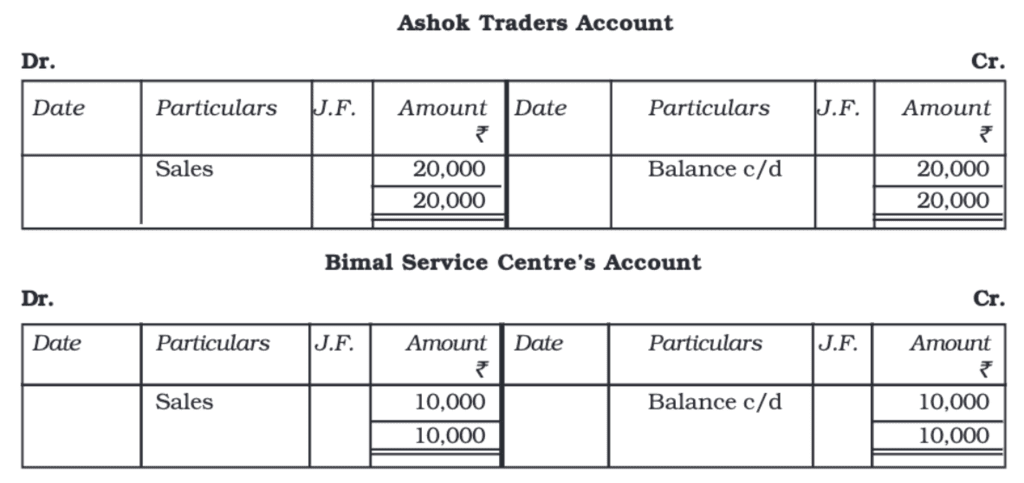
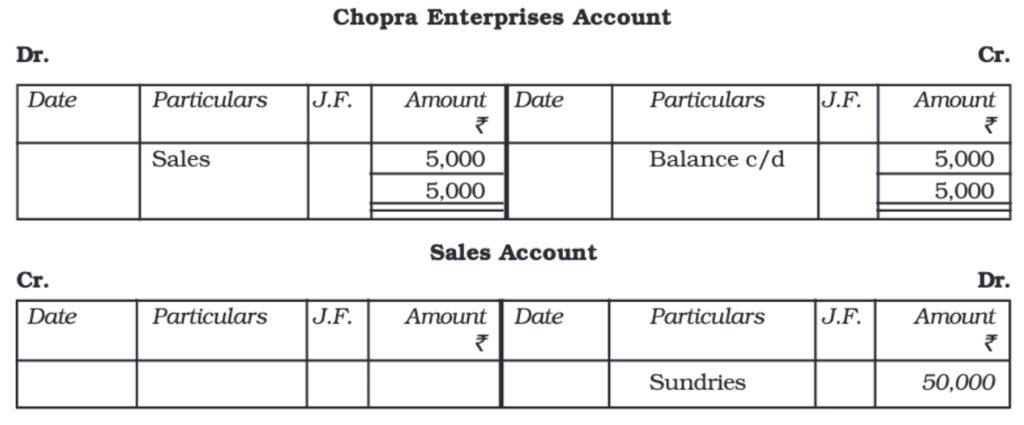
- The trial balance created from the above balances will not be equal. The total in the credit column will be ₹50,000 and the total in the debit column will be ₹35,000. This results in a difference of ₹15,000. This difference will temporarily be placed in a suspense account to make the trial balance match in the ledger.
- In this case, the difference in the trial balance is due to a one-sided error, specifically, the failure to post to the account of Diwakar and Sons. In real life, there can be many other similar one-sided errors that can cause a difference in the trial balance, requiring the creation of a suspense account. Until all the errors that affect the trial balance are found, it is not possible to fix them and make the trial balance equal. Therefore, the difference is shown in the suspense account, and the totals of the debit and credit columns are calculated to continue the accounting process.
- Once the errors are identified and the specific accounts and amounts involved are found, the amounts can be moved from the suspense account to the appropriate accounts, which will close the suspense account. Thus, the suspense account is not classified into any specific category of accounts; it is only a temporary measure.
- When correcting one-sided errors using a suspense account, the following steps are taken:
- Identify the account affected by the error.
- Determine the amount of excess debit/credit or short debit/credit in the affected account.
- If the error has led to an excess debit or a short credit in the affected account, credit the account with the amount of the excess debit or short credit.
- If the error has led to an excess credit or a short debit in the affected account, debit the account with the amount of excess credit or short debit.
- Finish the journal entry by debiting or crediting the suspense account, depending on the other account involved.
Rectification of Errors using Suspense Account
Some examples of rectifying errors using the Suspense Account are as follows:
1. Credit sales of ₹ 10,000 to Mohan were not recorded in his account. This is an error of partial omission that occurred while posting entries from the sales book. The wrong effect has been:

The correct effect should have been:

The rectification entry will be:

2. When credit sales of ₹10,000 to Mohan were recorded, an error occurred, and his account was mistakenly credited with only ₹7,000. This type of mistake is known as an error of commission. As a result, Mohan's account was under-debited by ₹3,000. The incorrect entry had the following impact:

The correct effect should have been:

The rectification entry will be:

3. Errors in Casting of Subsidiary Books: When there is an error in casting the subsidiary books, it only affects the accounts where the totals of those books are posted. The accounts of individual parties are not impacted by these errors.
For example, if the purchases book is overcast by ` 1,000, it will only affect the accounts where the totals are posted, not the individual party accounts.
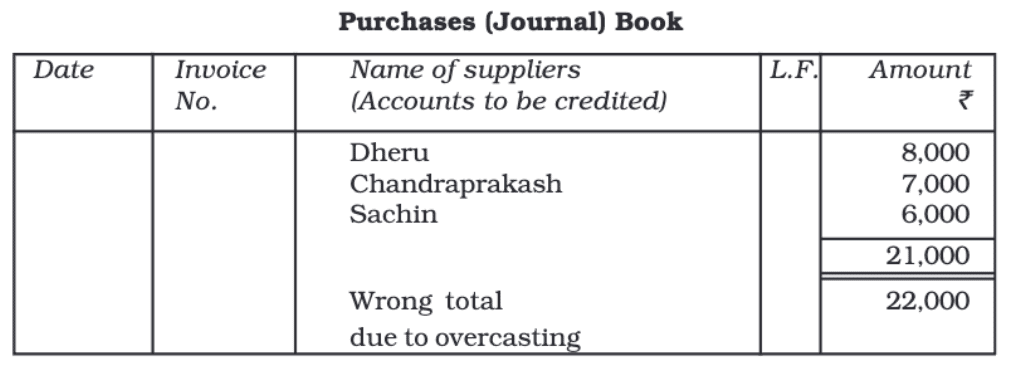
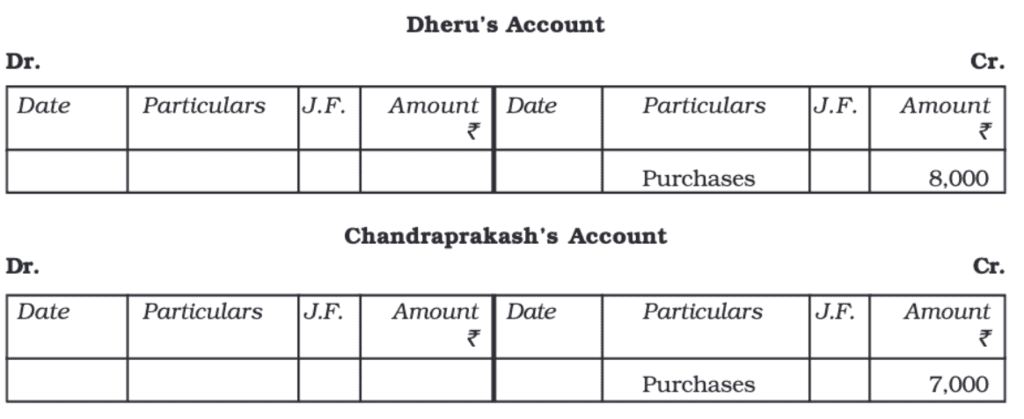
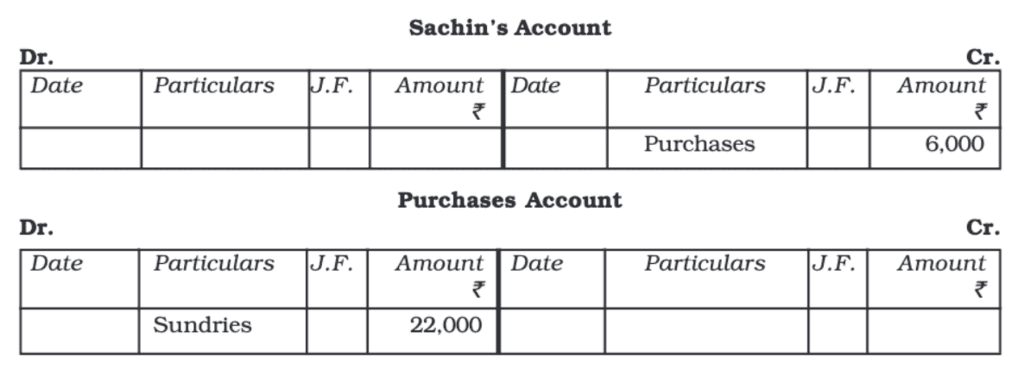
As you can notice there is no error in accounts of Dheeru, Chanderprakash and Sachin. Only the purchases account has been debited with ` 1,000 extra.
Hence, the rectification entry will be:

Rectification of Errors in the Next Accounting Year
- If errors made during the accounting year are not found and fixed before the financial statements are completed, the suspense account cannot be closed. Instead, the balance in the suspense account is carried forward to the next accounting period, meaning it stays open until the errors are corrected.
- When these errors are finally found and corrected in the following year, instead of adjusting the usual accounts like expenses, losses, incomes, or gains, the corrections are made through a special account called the profit and loss adjustment account. This is done to prevent these corrections from affecting the income statement of the new accounting period, keeping the financial results of that year fair and accurate.
You will learn more details about this process later in your accounting studies when you reach advanced topics.
Guiding Principles of Rectification of Errors
Errors in Books of Original Entry:
If an error happens in the very first record of a transaction (called the books of original entry), it is assumed that all later postings to other accounts have been made correctly based on that error.
Errors at the Posting Stage:
If the mistake occurs when posting from the original books to the ledger accounts, it is assumed that the original recording in the subsidiary books (like the sales book or purchase book) was done correctly.
Posting to the Wrong Account:
If an entry is posted to the wrong account but it’s not clear which side (debit or credit) or how much was posted, we assume the posting was made on the correct side and with the correct amount.
Correct Account but Wrong Amount:
If the posting is made to the correct account but with the wrong amount, and it’s not clear whether the debit or credit side was affected, we assume the posting was done on the correct side (debit or credit).
Wrong Account on Wrong Side:
If the posting is to the wrong account and on the wrong side (debit instead of credit or vice versa), and the amount is not mentioned, it is assumed the amount posted is the same as the original transaction amount.
Wrong Account with Wrong Amount:
If the posting is to the wrong account with the wrong amount, and the side (debit or credit) is not mentioned, it is assumed that the posting was done on the right side.
Correct Account on Wrong Side:
If the posting is made to the correct account but on the wrong side, and the amount is not mentioned, it is assumed that the correct amount was posted as per the original transaction.
Errors in Individual Transactions in Subsidiary Books:
If there is an error in posting individual transactions recorded in subsidiary books (like sales book or purchase book), it affects only the individual account concerned and does not impact the main sales, purchase, sales return, or purchase return accounts.
|
61 videos|154 docs|35 tests
|
FAQs on Trial Balance and Rectification of Errors Chapter Notes - Accountancy Class 11 - Commerce
| 1. What is the meaning of a Trial Balance in accounting? |  |
| 2. What are the main objectives of preparing a Trial Balance? |  |
| 3. How can one locate errors while preparing a Trial Balance? |  |
| 4. What is the significance of the agreement of a Trial Balance? |  |
| 5. What are the common methods for rectifying errors found in a Trial Balance? |  |

















